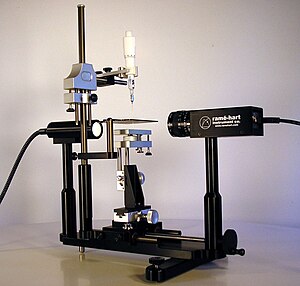Tensiometer (surface tension)
The term tensiometer applies to at least two different devices, one designed to measure the surface tension () of liquids and the other to determine matric water potential () (soil moisture tension) in the vadose zone.
Types
This section is empty. You can help by adding to it. (July 2010) |
Goniometer/Tensiometer

Surface scientist use a Goniometer/Tensiometer to measure the surface tension and interfacial tension of a liquid using the pendant or sessile drop methods. A drop is produced and the profile is then captured using a goniometer/tensiometer. The software then analyses the profile of the drop and makes a series of critical measurements. With pendant drops, for example, the maximum diameter and the ratio between this parameter and the diameter at the distance of the maximum diameter from the drop apex is evaluated and formulas are used to derive on the basis of the Young-Laplace equation the surface tension. Sophisticated software routines automate this computationally intensive process. The DROPimage Advanced software program under license from ramé-hart instrument company (Netcong, NJ, USA) is an example of this drop shape analysis software used to measure surface and interfacial tension using drop shape analysis.
Du Noüy-Padday Rod Pull Tensiometer
This method uses a rod which is lowered into a test liquid. The rod is then pulled out of the liquid and the force required to pull the rod is precisely measured. This is a rather novel method which is accurate and repeatable. The Du Noüy-Padday Rod Pull Tensiometer will take measurements quickly and unlike the ring and plate methods, will work with liquids with a wide range of viscosities.
Du Noüy Ring Tensiometer

This type of tensiometer uses a platinum ring which is submersed in a liquid. As the ring is pulled out of the liquid, the tension required is precisely measured in order to determine the surface tension of the liquid. This method requires that the platinum ring be nearly perfect; even a small blemish or scratch can greatly alter the accuracy of the results. A correction for buoyancy must be made. This method is considered obsolete and is no longer widely used.
Wilhelmy Plate Tensiometer
The Wilhelmy Plate tensiometer requires a plate to be pulled out of a liquid. The force required to lift the plate is measured and the surface tension is determined. This method is no longer widely used.
See also
References
- Rawls, W.J., Ahuja, L.R., Brakensiek, D.L., and Shirmohammadi, A. 1993. Infiltration and soil water movement, in Maidment, D.R., Ed., Handbook of hydrology, New York, NY, USA, McGraw-Hill, p. 5.1–5.51.


